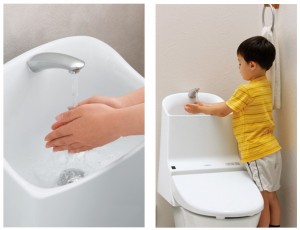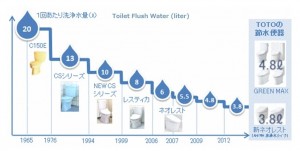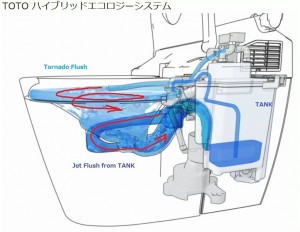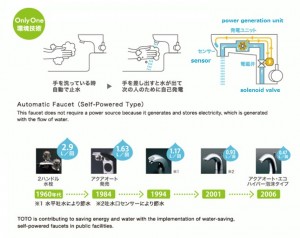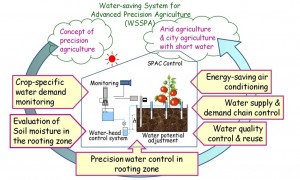Kikuo Hayakawa, NOST Tokyo
Origineel gepubliceerd op de site van RVO.
Samenvatting
Meer dan 70% van Japan bestaat uit bergen en ongeveer 90% van het kraanwater is afkomstig van rivieren en meren. De watervoorziening kan daardoor sterk afhankelijk zijn van het klimaat in een bepaalde regio. Zo kunnen een tekort aan neerslag of aardbevingen de toevoer blokkeren.
Om deze maatschappelijke onzekerheden het hoofd te bieden, hebben Japanse bedrijven unieke waterbesparende technologieën ontwikkeld. Met name op het terrein van sanitaire voorzieningen. In de afgelopen 20 jaar is het spoelwater voor wc’s met de helft verminderd. Veel openbare toiletten zijn uitgerust met kranen die de waterstroom automatisch stoppen na gebruik. Japanse bedrijven als TOTO en LIXIL zijn de belangrijkste spelers op dit gebied.
Daarnaast zijn er waterbesparende projecten in de landbouw en woonwijken. Prof. Sakae Shibusawa van Tokyo University of Agriculture and Technology heeft een waterbesparend watersysteem ontwikkeld voor de precisielandbouw. In een ecologisch stadsproject, Fujisawa Sustainable Smart Town, wil men 30% minder watergebruik in een woonwijk realiseren.
Details
Japan is one of rainiest regions in the world. Japan has an average yearly precipitation of 1,700 millimeters. It is about double the world average. But the annual precipitation per capita is around one third the world average. (1) About eighty eight percent of Japanese water resources come from rivers, lakes and marshes. (2) Therefore, Japanese water supply is potentially influenced by regional climates such as a shortage of precipitation. In Japan, local governments are responsible for water supply services in their regions. So they have promoted their regional citizens and companies to reduce water consumption especially in case of a lack of rainfall in summer. ‘Sessui’ means saving-water in Japanese. Local Governments promote a Sessui campaign in case of the water shortage. Japanese families consume about half the amount of tap water in average for both toilets and bathrooms. (3) Responded to the societal background, saving water technologies on sanitary goods have been uniquely developed in Japan. A couple of Japanese companies, TOTO and LIXIL, are the major players in this field. They have developed high-performance water-saving sanitary goods since 1970’s.
Water-saving toilets
In Japan, toilets consume the most tap water at home, accounting for twenty eight percent. (3) At present, most Japanese houses already have water-saving toilets such as in Figure 1. All the water used for washing hands will be stored in the tank to reuse as flush water. In Japan, washing-hands toilets were introduced on the market more than thirty years ago. Although there are no strict guidelines and regulations regarding water-saving toilets in Japan, the high-performance water-saving toilets are supported by the public due to the above mentioned societal background. Actually, more than fifty percent of toilet flush water has been reduced in the past twenty years. In 1976, toilets consumed thirteen liters per flush. The recent models consume only 4.8 liters (or 3.8 liters for floor pipe type) per flush (Fig. 2). TOTO’s latest model, Neorest Hybrid Toilet Series is equipped with a Hybrid Ecology System (Fig. 3). It has a new flushing system equipped with both a Tornado Flush using low pressure water and a Jet Flush using high pressure water from a tank, which cleans and flushes both the rim and bowl in an innovative way. It creates a whirlpool effect that cleans the entire surface. It is quiet and water-efficient. (4) The TOTO’s Hybrid Ecology System received a Daily Commodity Component Award in 2008. (5) The similar type of high-end water-saving toilet, SATIS, has been produced by the other company LIXIL (former LINAX). TOTO and LIXIL lead the development of water-saving toilets in Japan.
Figure 1. Japanese water saving toilet to reuse hand-washing water (source: TOTO)
Figure 2. History of toilet flush water saving (source: TOTO)
Figure 3. TOTO Hybrid Ecology System (source: TOTO)
Faucets
In Japan, the amount of water on a daily basis has doubled in the past forty years. About three hundreds liters per person is used daily in Japan. In order to reduce the amount of water consumption, many Japanese public bathrooms are equipped with self-powered faucets to stop the flow of water automatically (Fig. 4). A hand sensor controls a solenoid valve to just open during washing hands. The sensor is powered by a storage device in faucet which electricity was generated by the water flow. The first automatic faucet was released in Japan in 1984. The recent faucets only use 0.47 liters per hand wash, which saves about eighty four percent of tap water compared with 1960’s. The recent tap water combines with air bubbles to reduce the amount of water.
Figure 4. Automatic faucet and history of public faucets (source: TOTO )
Agriculture
The agricultural sector is a major user of water resources. In the world, agricultural industries use about seventy percent of water resources in average. In Japan, they use about sixty five percent of water resources. And also about seventy to eighty percent of the agricultural water is used for rice fields. Until recently Japan has focused on the development of new water resources such as irrigation water and water reservoirs, to secure water for agriculture. But it has not focused on developments of water-saving technologies for agriculture. Prof. Sakae Shibusawa of Tokyo University of Agriculture and Technology is leading Japan on the development of water-saving technologies for agriculture. Prof Shibusawa is the head of a five-year project, ‘Water-saving System for Advanced Precision Agriculture (WSSPA)’, which is one of CREST water programs funded by the Japan Science and Technology Agency (JST). (6) WSSPA focuses on the innovative technologies of advanced water-saving agriculture which enable water supply with the correct amount, at the right time and at the correct location (Fig. 5). According to WSSPA, the targeted core technologies are 1) underground capillary irrigation technologies to meet the small reduction in water potential around the rooting zone when the plant absorbs, 2) Instrumentation technologies of soil water capacity and water stresses of plant, 3) Energy-reduced and high-efficient air conditioning/environmental control system in greenhouse with a water-purification and water recycle technologies. The innovative approach is that plants are supplied water from the underground as natural plants do. It needs no electric pump to supply water. Water moves from a tank to plant roots by capillary power. When the soil around plant roots is dry, the soil pressure is lower and the tank water is moved to the soils of plant roots to balance the pressure gap between them. At WSSPA, Prof. Shibusawa aims to halve the water supply for plants compared with the conventional one. He indicated that only five percent of the water is used by plants for growth. The other ninety five percent water plays a role as a carrier of nutrition and a temperature conditioner. Prof. Shibusawa claims that the rest ninety five percent water can be ideally recycled for plants in greenhouse. Possible applications of WSSPA are water-saving greenhouse/plant factory, water-saving orchard management, paddy water control system FOEAS, soil moisture/ nutrient mapping and control system. Furthermore, WSSPA will be also applicable to water-saving agriculture in arid lands. WSSPA’s co-researchers are the is University of Tokyo and Toin University of Yokohama. This research started in April 2010 and will be complete in March 2015. Its budget is 1.4 million euro for five years. The above mentioned FOEAS ( Farm-Oriented Enhancement for Aquatic System) is a Japanese modern paddy water control system developed by National Agriculture and Food Research Organization (NARO) and a Japanese company Paddy Research Co. (7) FOEAS consists of a system including underground irrigation water retention tubes. FOEAS aims to cultivate crops and potatoes in off-season rice fields. Some paddy projects have already started using FOEAS.
Figure 5. Water-saving System for Advanced Precision Agriculture (source: Prof. Sakae Shibusawa, Tokyo University of Agriculture and Technology)
Water-saving as smart promotion
In Japan, many manufacturing companies are busy trying to reduce and reuse water in factories and plants in the framework of corporate social responsibility. For instance, Coca Cola Japan has achieved to use an average 5.25 liters per litter bottle, which is about 15.7 percent reduction compared with five years ago. Hitachi has achieved fifty two percent water reduction at their factories in the world compared with seven years ago. And also in Japan, water-saving is one of ‘smart’ elements when a new community project is developed. A new ecology town community project, Fujisawa Sustainable Smart Town (Fujisawa SST) has started in 2011 joined by Fujisawa City and eight companies such as Panasonic and Mitsui Fudosan. Fujisawa STT is located in the area of a former Panasonic factory in Fujisawa City, Kanagawa Prefecture and will be completed in 2018. Fujisawa SST consists of a thousand new smart houses networked in the community. It aims to achieve thirty percent water reduction within the community. And it aims to reduce about seventy percent CO2-emissions compared with 1990.
Currency:
1 euro = 141 yen (as of March 20, 2014)
Sources:
1) Building an Ultra Water Saving Society, Building Research Instiute
2) Water Resources in Japan, MLIT
3) Links and Linking, The Story of Water, TOTO
4) TOTO’s Neorest Hybrid Toilet video
5) Daily Comodity Component Award, Conference of the promotion of Monozukuri
7) A new water control system for cultivation of upland crops in paddy fields ( FOEAS), NARO

